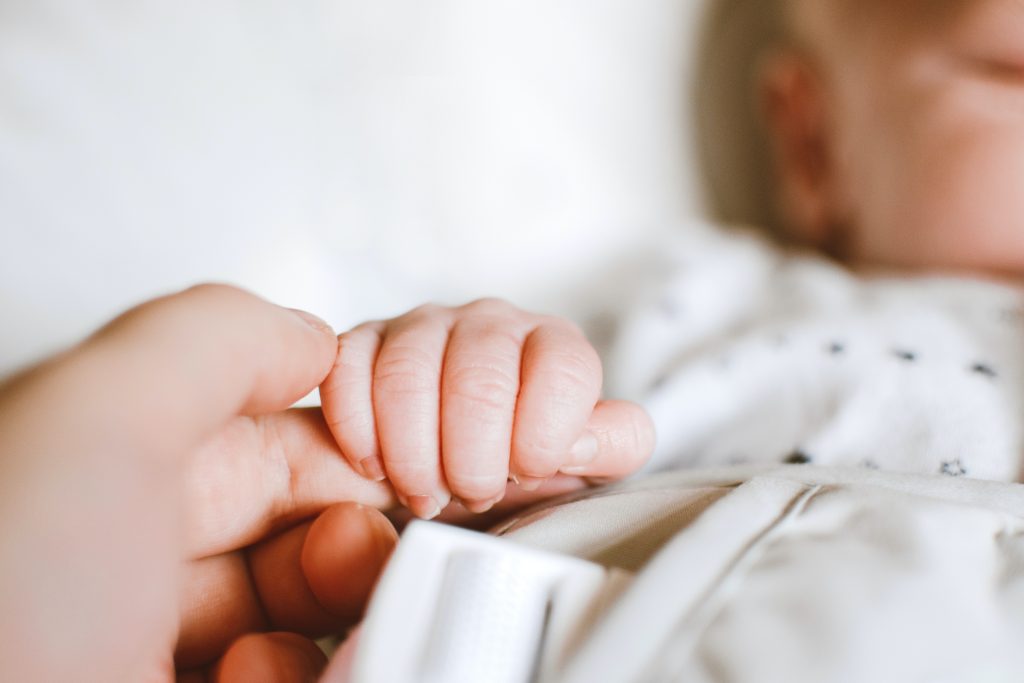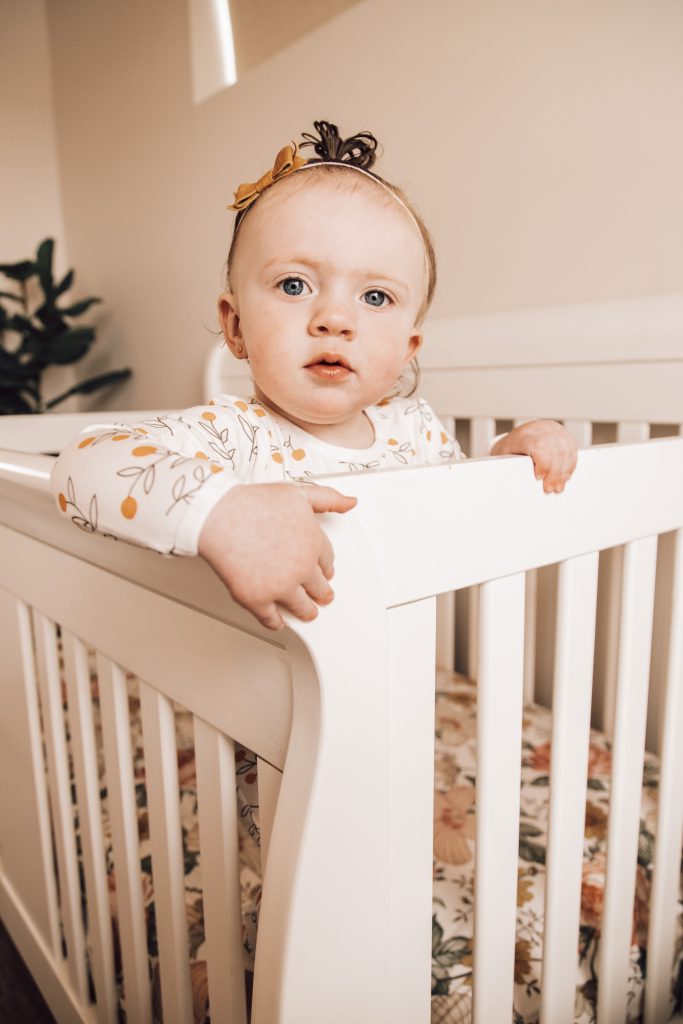
This post was originally published on October 6, 2022.
There are few things more important during those early days of motherhood as snuggles and sleep. It’s important to start safe sleep habits before you even bring your newborn home from the hospital. Thankfully, Dr. Erinn Ojard Schmit, a mother of two and a pediatric physician at Children’s of Alabama and UAB Pediatrics is here with Birmingham Mom Collective today to share her expertise with our readers!
Sleep Safety is Personal
Dr. Schmit takes infant sleep safety very seriously. To her, it’s personal. Her cousin died of SIDS (Sudden Infant Death Syndrome), and the way her family mourned her cousin’s loss really stuck with her.
Sleep-related deaths are especially tragic because many of them could be prevented. Throughout Dr. Schmit’s pediatrics training and career, she’s always been passionate about discussing safe sleep in an effort to prevent such a tragedy from happening to another family.
Statistics from Our State
Another reason that safe sleep is so important is that the state of Alabama has one of the highest rates of sleep-related deaths in the country. Every year in the U.S., approximately 3,500 babies die due to sleep-related causes (including SIDS, suffocation, strangulation, and asphyxia). That’s more than the number of deaths due to drowning and motor vehicle accidents combined!
It’s so important that we talk about safe sleep, just like we talk about car seat safety and drowning prevention. In Alabama, doctors typically see around 100 infant deaths each year due to sleep-related causes or from their sleeping environments.
A Safe Sleep Environment
The highest risk of sleep-related deaths is in infants up to six months of age. After that, the risk is lower but still present, so the American Academy of Pediatrics recommends following safe sleep practices until 12 months of age.
Dr. Schmit recommends the ABCs of safe sleep:
-
- Alone
- Back
- Crib
Babies should sleep by themselves—never with another person—because this puts them at risk of suffocation.
They should always be placed on their backs to sleep for every sleep session (including both naps and bedtime). Sleeping on their tummy or side is unsafe and increases the risk of death. Once a baby can roll both ways by himself or herself, you can allow your baby to roll into whatever position your baby would like (including onto their tummy). However, babies should still be placed down for sleep on their backs.
Babies should sleep in a crib, portable crib, or bassinet. Any Consumer Product Safety Commission-approved device that is a flat, firm surface without any elevation or angle is fine. Babies should share a room—but not a bed—with parents or caregivers.
Finally, the sleep space should be free of anything but the baby and a tight-fitted sheet on a firm mattress. There should be no loose blankets, pillows, crib bumpers, stuffed animals, or other soft materials since these are all suffocation risks. Babies can be put down in pajamas or a wearable blanket, but loose blankets should be avoided because these can cover their faces.

She recommends that all babies follow safe sleep recommendations for 12 months, then it is okay to introduce a loose blanket, small pillow, or stuffed animal.
Other Safe Sleep Factors
There are other factors to a safe sleep environment that parents should keep in mind. Parents should avoid using any loose cords near the infant’s crib, including video monitor cords, window covering cords, or electrical wires because these can be a strangulation risk.
Pregnant mothers should avoid smoking during pregnancy and avoid second-hand smoke exposure after the baby is born to reduce the risk of SIDS. Breastfeeding or feeding expressed breastmilk is protective against SIDS, as is offering a pacifier.
Even in babies with reflux, the head of the bed should not be elevated. Doing so can put the baby in an unsafe position which can cause airway compromise. Plus, it has not been shown to be helpful in reducing reflux.
Although there are many products marketed for infant sleep, they are not always safe. Parents should be especially cautious of using any inclined positioners or soft surfaces.
The Safe Sleep for Babies Act of 2021 recently went into effect. It prohibits the sale of crib bumpers and inclined sleepers for infants. However, this does not impact items for sale second-hand, so parents should be aware of this if purchasing products in these situations.
The Dangers of Co-Sleeping
There is no safe way to practice co-sleeping (sharing a bed or sleep surface with a baby). However, there are ways you can reduce the risks associated with co-sleeping. Avoid sleeping in an armchair or on a couch with babies, as these places are extremely dangerous and greatly increase the risk of death (by up to 67 times).
If you choose to co-sleep, it should be done on a bare mattress with only a fitted sheet and without any pillows, blankets, or soft bedding. Parents or caregivers should avoid the use of medications or substances which can cause drowsiness (including prescriptions, alcohol, marijuana, or drugs). Co-sleeping is especially dangerous under four months of age and should be avoided. Pets should also not be allowed to sleep in the bed with an infant.
The safest way for babies to sleep is in their own sleep space (bassinet, crib, or portable crib such as a pack-and-play). Sharing a room with parents or caregivers is great, just don’t share a bed. Sharing a room decreases the risk of SIDS by up to half. Ideally babies will share a room for at least the first six months, then transition to a crib in their own room.
Parents who do not intend to co-sleep but find themselves falling asleep in bed with their infant can try certain tactics. Set an alarm or do an activity to prevent yourself from falling asleep (like watching television). If you find that you have fallen asleep unintentionally, move the baby back to his or her own sleep space as soon as you wake up.
Beyond the Crib
There isn’t a standard age to transition a child out of a crib since it is usually dependent on the child. Dr. Schmit typically recommends that as toddlers get bigger and start to try to climb out of the crib, lower the mattress. If they are still able to climb out, they should be transitioned to a bed because in trying to climb out, they could fall off the top rail of the crib and hurt themselves. Many toddlers or young children can then use a toddler bed or bed rails.

For more information, Dr. Schmit recommends the Safe to Sleep website, especially the section on “Safe Infant Sleep Basics.” She also recommends healthychildren.org’s article, “How to Keep Your Sleeping Baby Safe: AAP Policy Explained” by Dr. Rachel Moon.
Finally, please talk with your pediatrician if you have further questions about safe sleep or need more advice.











